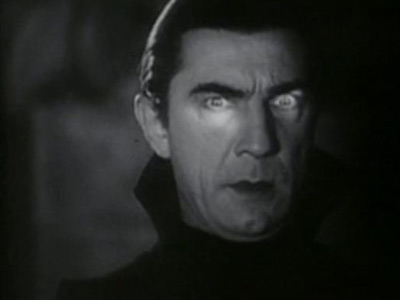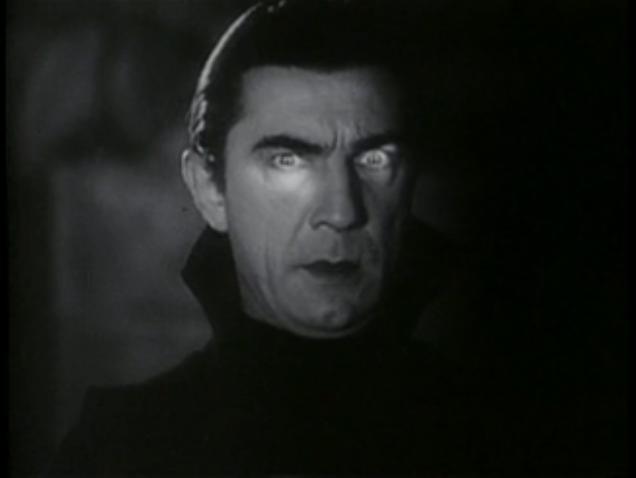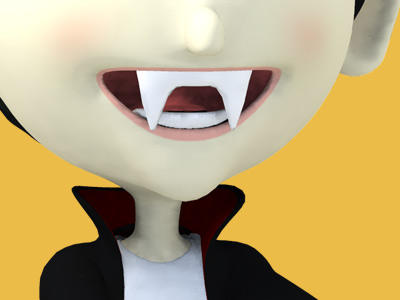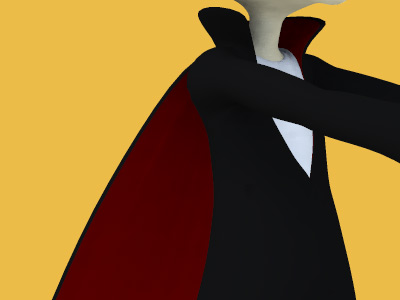Vampire

A vampire is a being from folklore who subsists by feeding on the life essence (generally in the form of blood) of living creatures. Undead beings, vampires often visited loved ones and caused mischief or deaths in the neighbourhoods they inhabited when they were alive. They wore shrouds and were often described as bloated and of ruddy or dark countenance, markedly different from today's gaunt, pale vampire which dates from the early 19th century.
Although vampiric entities have been recorded in most cultures, the term vampire was not popularized in the west until the early 18th century, after an influx of vampire superstition into Western Europe from areas where vampire legends were frequent, such as the Balkans and Eastern Europe, although local variants were also known by different names, such as shtriga in Albania, vrykolakas in Greece and strigoi in Romania. This increased level of vampire superstition in Europe led to what can only be called mass hysteria and in some cases resulted in corpses actually being staked and people being accused of vampirism.
In modern times, however, the vampire is generally held to be a fictitious entity, although belief in similar vampiric creatures such as the chupacabra still persists in some cultures. Early folk belief in vampires has sometimes been ascribed to the ignorance of the body's process of decomposition after death and how people in pre-industrial societies tried to rationalise this, creating the figure of the vampire to explain the mysteries of death. Porphyria was also linked with legends of vampirism in 1985 and received much media exposure, but has since been largely discredited.
The charismatic and sophisticated vampire of modern fiction was born in 1819 with the publication of The Vampyre by John Polidori; the story was highly successful and arguably the most influential vampire work of the early 19th century. However, it is Bram Stoker's 1897 novel Dracula which is remembered as the quintessential vampire novel and provided the basis of the modern vampire legend. The success of this book spawned a distinctive vampire genre, still popular in the 21st century, with books, films, and television shows. The vampire has since become a dominant figure in the horror genre.
Folk beliefs
The notion of vampirism has existed for millennia. Cultures such as the Mesopotamians, Hebrews, Ancient Greeks, and Romans had tales of demons and spirits which are considered precursors to modern vampires. However, despite the occurrence of vampire-like creatures in these ancient civilizations, the folklore for the entity we know today as the vampire originates almost exclusively from early-18th-century southeastern Europe, when verbal traditions of many ethnic groups of the region were recorded and published. In most cases, vampires are revenants of evil beings, suicide victims, or witches, but they can also be created by a malevolent spirit possessing a corpse or by being bitten by a vampire. Belief in such legends became so pervasive that in some areas it caused mass hysteria and even public executions of people believed to be vampires
Description and common attributes
It is difficult to make a single, definitive description of the folkloric vampire, though there are several elements common to many European legends. Vampires were usually reported as bloated in appearance, and ruddy, purplish, or dark in colour; these characteristics were often attributed to the recent drinking of blood. Indeed, blood was often seen seeping from the mouth and nose when one was seen in its shroud or coffin and its left eye was often open. It would be clad in the linen shroud it was buried in, and its teeth, hair, and nails may have grown somewhat, though in general fangs were not a feature.

Creating vampires
The causes of vampiric generation were many and varied in original folklore. In Slavic and Chinese traditions, any corpse that was jumped over by an animal, particularly a dog or a cat, was feared to become one of the undead. A body with a wound that had not been treated with boiling water was also at risk. In Russian folklore, vampires were said to have once been witches or people who had rebelled against the Russian Orthodox Church while they were alive.
Cultural practices often arose that were intended to prevent a recently deceased loved one from turning into an undead revenant. Burying a corpse upside-down was widespread, as was placing earthly objects, such as scythes or sickles, near the grave to satisfy any demons entering the body or to appease the dead so that it would not wish to arise from its coffin. This method resembles the Ancient Greek practice of placing an obolus in the corpse's mouth to pay the toll to cross the River Styx in the underworld. It has been argued that instead, the coin was intended to ward off any evil spirits from entering the body, and this may have influenced later vampire folklore. This tradition persisted in modern Greek folklore about the vrykolakas, in which a wax cross and piece of pottery with the inscription "Jesus Christ conquers" were placed on the corpse to prevent the body from becoming a vampire.
Other methods commonly practised in Europe included severing the tendons at the knees or placing poppy seeds, millet, or sand on the ground at the grave site of a presumed vampire; this was intended to keep the vampire occupied all night by counting the fallen grains, indicating an association of vampires with arithmomania. Similar Chinese narratives state that if a vampire-like being came across a sack of rice, it would have to count every grain; this is a theme encountered in myths from the Indian subcontinent, as well as in South American tales of witches and other sorts of evil or mischievous spirits or beings.
In Albanian folklore, the dhampir is the hybrid child of the karkanxholl (a werewolf-like creature with an iron mail shirt) or the lugat (a water-dwelling ghost or monster). The dhampir sprung of a karkanxholl has the unique ability to discern the karkanxholl; from this derives the expression the dhampir knows the lugat. The lugat cannot be seen, he can only be killed by the dhampir, who himself is usually the son of a lugat. In different regions, animals can be revenants as lugats; also, living people during their sleep. Dhampiraj is also an Albanian surname.
Identifying vampires
Many elaborate rituals were used to identify a vampire. One method of finding a vampire's grave involved leading a virgin boy through a graveyard or church grounds on a virgin stallion—the horse would supposedly balk at the grave in question. Generally a black horse was required, though in Albania it should be white. Holes appearing in the earth over a grave were taken as a sign of vampirism.
Corpses thought to be vampires were generally described as having a healthier appearance than expected, plump and showing little or no signs of decomposition. In some cases, when suspected graves were opened, villagers even described the corpse as having fresh blood from a victim all over its face. Evidence that a vampire was active in a given locality included death of cattle, sheep, relatives or neighbours. Folkloric vampires could also make their presence felt by engaging in minor poltergeist-like activity, such as hurling stones on roofs or moving household objects, and pressing on people in their sleep.
Apotropaics
Apotropaics, items able to ward off revenants, are common in vampire folklore. Garlic is a common example,[35] a branch of wild rose and hawthorn plant are said to harm vampires, and in Europe, sprinkling mustard seeds on the roof of a house was said to keep them away. Other apotropaics include sacred items, for example a crucifix, rosary, or holy water. Vampires are said to be unable to walk on consecrated ground, such as that of churches or temples, or cross running water.
Although not traditionally regarded as an apotropaic, mirrors have been used to ward off vampires when placed, facing outwards, on a door (in some cultures, vampires do not have a reflection and sometimes do not cast a shadow, perhaps as a manifestation of the vampire's lack of a soul). This attribute, although not universal (the Greek vrykolakas/tympanios was capable of both reflection and shadow), was used by Bram Stoker in Dracula and has remained popular with subsequent authors and filmmakers.
Some traditions also hold that a vampire cannot enter a house unless invited by the owner, although after the first invitation they can come and go as they please. Though folkloric vampires were believed to be more active at night, they were not generally considered vulnerable to sunlight
Methods of destruction
Methods of destroying suspected vampires varied, with staking the most commonly cited method, particularly in southern Slavic cultures. Ash was the preferred wood in Russia and the Baltic states, or hawthorn in Serbia, with a record of oak in Silesia. Potential vampires were most often staked through the heart, though the mouth was targeted in Russia and northern Germany and the stomach in north-eastern Serbia.
Piercing the skin of the chest was a way of "deflating" the bloated vampire. This is similar to the act of burying sharp objects, such as sickles, in with the corpse, so that they may penetrate the skin if the body bloats sufficiently while transforming into a revenant. In one striking example of the latter, the corpses of five people in graveyard near Polish village of Dravsko dating from the 17th and 18th centuries were buried with sickles placed around their necks or across their abdomens.
Decapitation was the preferred method in German and western Slavic areas, with the head buried between the feet, behind the buttocks or away from the body. This act was seen as a way of hastening the departure of the soul, which in some cultures, was said to linger in the corpse. The vampire's head, body, or clothes could also be spiked and pinned to the earth to prevent rising.
Romani people drove steel or iron needles into a corpse's heart and placed bits of steel in the mouth, over the eyes, ears and between the fingers at the time of burial. They also placed hawthorn in the corpse's sock or drove a hawthorn stake through the legs. In a 16th-century burial near Venice, a brick forced into the mouth of a female corpse has been interpreted as a vampire-slaying ritual by the archaeologists who discovered it in 2006.
Further measures included pouring boiling water over the grave or complete incineration of the body. In the Balkans, a vampire could also be killed by being shot or drowned, by repeating the funeral service, by sprinkling holy water on the body, or by exorcism. In Romania, garlic could be placed in the mouth, and as recently as the 19th century, the precaution of shooting a bullet through the coffin was taken. For resistant cases, the body was dismembered and the pieces burned, mixed with water, and administered to family members as a cure. In Saxon regions of Germany, a lemon was placed in the mouth of suspected vampires.
In Bulgaria, over 100 skeletons with metal objects, such as plough bits, embedded in the torso have been discovered
Ancient beliefs
Tales of supernatural beings consuming the blood or flesh of the living have been found in nearly every culture around the world for many centuries. The term vampire did not exist in ancient times. Blood drinking and similar activities were attributed to demons or spirits who would eat flesh and drink blood; even the Devil was considered synonymous with the vampire.
Almost every nation has associated blood drinking with some kind of revenant or demon, or in some cases a deity. In India, for example, tales of vetālas, ghoul-like beings that inhabit corpses, have been compiled in the Baitāl Pacīsī; a prominent story in the Kathāsaritsāgara tells of King Vikramāditya and his nightly quests to capture an elusive one. Piśāca, the returned spirits of evil-doers or those who died insane, also bear vampiric attributes.
The Persians were one of the first civilizations to have tales of blood-drinking demons: creatures attempting to drink blood from men were depicted on excavated pottery shards. Ancient Babylonia and Assyria had tales of the mythical Lilitu, synonymous with and giving rise to Lilith (Hebrew לילית) and her daughters the Lilu from Hebrew demonology. Lilitu was considered a demon and was often depicted as subsisting on the blood of babies. And Estries, female shape changing, blood drinking demons, were said to roam the night among the population, seeking victims. According to Sefer Hasidim, Estries were creatures created in the twilight hours before God rested. An injured Estrie could be healed by eating bread and salt given her by her attacker.
Ancient Greek and Roman mythology described the Empusae, the Lamia, and the striges. Over time the first two terms became general words to describe witches and demons respectively. Empusa was the daughter of the goddess Hecate and was described as a demonic, bronze-footed creature. She feasted on blood by transforming into a young woman and seduced men as they slept before drinking their blood. The Lamia preyed on young children in their beds at night, sucking their blood, as did the gelloudes or Gello. Like the Lamia, the striges feasted on children, but also preyed on young men. They were described as having the bodies of crows or birds in general, and were later incorporated into Roman mythology as strix, a kind of nocturnal bird that fed on human flesh and blood.
In Azerbaijanese mythology Xortdan is the troubled soul of the dead rising from the grave. Some Hortdan can be living people with certain magical properties. Some of the properties of the Hortdan include: the ability to transform into an animal, invisibility, and the propensity to drain the vitality of victims via blood loss.
Medieval and later European folklore
Many myths surrounding vampires originated during the medieval period. The 12th-century English historians and chroniclers Walter Map and William of Newburgh recorded accounts of revenants, though records in English legends of vampiric beings after this date are scant. The Old Norse draugr is another medieval example of an undead creature with similarities to vampires.
Vampires proper originate in folklore widely reported from Eastern Europe in the late 17th and 18th centuries. These tales formed the basis of the vampire legend that later entered Germany and England, where they were subsequently embellished and popularized. One of the earliest recordings of vampire activity came from the region of Istria in modern Croatia, in 1672. Local reports cited the local vampire Jure Grando of the village Khring near Tinjan as the cause of panic among the villagers.
A former peasant, Jure died in 1656. However, local villagers claimed he returned from the dead and began drinking blood from the people and sexually harassing his widow. The village leader ordered a stake to be driven through his heart, but when the method failed to kill him, he was subsequently beheaded with better results. That was the first case in history that a real person had been described as a vampire.
During the 18th century, there was a frenzy of vampire sightings in Eastern Europe, with frequent stakings and grave diggings to identify and kill the potential revenants. Even government officials engaged in the hunting and staking of vampires. Despite being called the Age of Enlightenment, during which most folkloric legends were quelled, the belief in vampires increased dramatically, resulting in a mass hysteria throughout most of Europe.
The panic began with an outbreak of alleged vampire attacks in East Prussia in 1721 and in the Habsburg Monarchy from 1725 to 1734, which spread to other localities. Two famous vampire cases, the first to be officially recorded, involved the corpses of Petar Blagojevich and Arnold Paole from Serbia. Blagojevich was reported to have died at the age of 62, but allegedly returned after his death asking his son for food. When the son refused, he was found dead the following day. Blagojevich supposedly returned and attacked some neighbours who died from loss of blood.
In the second case, Paole, an ex-soldier turned farmer who allegedly was attacked by a vampire years before, died while haying. After his death, people began to die in the surrounding area and it was widely believed that Paole had returned to prey on the neighbours. Another famous Serbian legend involving vampires concentrates around a certain Sava Savanović living in a watermill and killing and drinking blood from millers. The character was later used in a story written by Serbian writer Milovan Glišić and in the Yugoslav 1973 horror film Leptirica inspired by the story.
The two incidents were well-documented. Government officials examined the bodies, wrote case reports, and published books throughout Europe. The hysteria, commonly referred to as the "18th-Century Vampire Controversy", raged for a generation. The problem was exacerbated by rural epidemics of so-claimed vampire attacks, undoubtedly caused by the higher amount of superstition that was present in village communities, with locals digging up bodies and in some cases, staking them.
Although many scholars reported during this period that vampires did not exist, and attributed reports to premature burial or rabies, superstitious belief increased. Dom Augustine Calmet, a well-respected French theologian and scholar, put together a comprehensive treatise in 1746, which was ambiguous concerning the existence of vampires. Calmet amassed reports of vampire incidents - numerous readers, including both a critical Voltaire and supportive demonologists, interpreted the treatise as claiming that vampires existed. In his Philosophical Dictionary, Voltaire wrote:
"These vampires were corpses, who went out of their graves at night to suck the blood of the living, either at their throats or stomachs, after which they returned to their cemeteries. The persons so sucked waned, grew pale, and fell into consumption; while the sucking corpses grew fat, got rosy, and enjoyed an excellent appetite. It was in Poland, Hungary, Silesia, Moravia, Austria, and Lorraine, that the dead made this good cheer."
Some theological disputes arose. The non-decay of vampires' bodies could recall the incorruption of the bodies of the saints of the Catholic Church. A paragraph on vampires was included in the second edition (1749) of De servorum Dei beatificatione et sanctorum canonizatione, On the beatification of the servants of God and on canonization of the blessed, written by Prospero Lambertini (Pope Benedict XIV). In his opinion, while the incorruption of the bodies of saints was the effect of a divine intervention, all the phenomena attributed to vampires were purely natural or the fruit of “imagination, terror and fear”. In other words, vampires did not exist.
The controversy only ceased when Empress Maria Theresa of Austria sent her personal physician, Gerard van Swieten, to investigate the claims of vampiric entities. He concluded that vampires did not exist and the Empress passed laws prohibiting the opening of graves and desecration of bodies, sounding the end of the vampire epidemics. Despite this condemnation, the vampire lived on in artistic works and in local superstition.
In modern fiction
The vampire is now a fixture in popular fiction. Such fiction began with 18th-century poetry and continued with 19th-century short stories, the first and most influential of which was John Polidori's The Vampyre (1819), featuring the vampire Lord Ruthven. Lord Ruthven's exploits were further explored in a series of vampire plays in which he was the anti-hero. The vampire theme continued in penny dreadful serial publications such as Varney the Vampire (1847) and culminated in the pre-eminent vampire novel of all time: Dracula by Bram Stoker, published in 1897.

Count Dracula as portrayed by Béla Lugosi in 1931's Dracula
Over time, some attributes now regarded as integral became incorporated into the vampire's profile: fangs and vulnerability to sunlight appeared over the course of the 19th century, with Varney the Vampire and Count Dracula both bearing protruding teeth, and Murnau's Nosferatu (1922) fearing daylight. The cloak appeared in stage productions of the 1920s, with a high collar introduced by playwright Hamilton Deane to help Dracula 'vanish' on stage. Lord Ruthven and Varney were able to be healed by moonlight, although no account of this is known in traditional folklore. Implied though not often explicitly documented in folklore, immortality is one attribute which features heavily in vampire film and literature. Much is made of the price of eternal life, namely the incessant need for blood of former equals.
LEGENDS

RESOURCES
This article uses material from the Wikipedia article "Vampire", which is released under the Creative Commons Attribution-Share-Alike License 3.0.
© Stories Preschool. All Rights Reserved.








